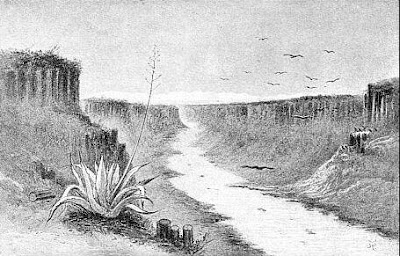 R. Santa Cruz
R. Santa CruzThe river was here very tortuous, & in many parts there were great blocks of Slate & Granite, which in former periods of commotion have come from the Andes: Both these causes sadly interfered with our progress. We had however the satisfaction of seeing in full view the long North & South range of the Cordilleras. They form a lofty & imposing barrier to this flat country; many of the mountains were steep & pointed cones, & these were clothed with snow. We looked at them with regret, for it was evident we had not time to reach them; We were obliged to imagine their nature & grandeur, instead of standing, as we had hoped, on one of their pinnacles & looking down on the plains below. During these two days we saw signs of horses & several little articles belonging to the Indians, such as a bunch of Ostrich feathers, part of a mantle, a pointed stick. From a thong of cows hide being found; it is certain that these Indians must come from the North. They probably have no connection with those whose smoke we saw nearer to the Coast; but that during the Summer they travel along the foot Andes, in order to hunt in fresh country. The Guanaco being so excessively abundant I was at first much surprised that Indians did not constantly reside on the banks of this river; the cause of their not frequenting these plains must be their stony nature (the whole country is a shingle bed) which no unshod horse could withstand. Yet in two places, in this very central part, I found small piles of stones which I think could not have been accidentally grouped together. They were placed on projecting points, over the highest lava cliffs; & resembled those at Port Desire, but were on a smaller scale. They would not have been sufficient to have covered more than the bones of a man.
Captain Fitzroy’s Journal:
We had great difficulty with the boats on the 2d, the river being contracted in width, without any diminution of the body of water pouring down.
We had great difficulty with the boats on the 2d, the river being contracted in width, without any diminution of the body of water pouring down.
No comments:
Post a Comment